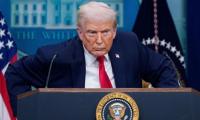Foreign investment in govt debt touches $2.915 billion
KARACHI: Foreign investment in government securities has reached $2.915 billion in the current fiscal year of 2019/20, the central bank data showed on Friday.
The country received a net $2.879 billion foreign investment in short term treasury bills from July 1, 2019 to January 30, 2020. Pakistan Investment Bonds attracted $36 million foreign investment in the period under review.
In the auction held on January 29, foreign investors pumped $209 million in Pakistan’s short-term government securities.
A major chunk of investments in the T-bills came from investors in the United Kingdom and the United States. Investment from the United Kingdom in T-bills clocked in at $2.016 billion followed by the US with $792.8 million.
Analysts said the appetite for Pakistan’s domestic debt has increased as the central bank hiked interest rates by 7.50 percentage points over a period, which resulted in unprecedented rise in treasury bills’ and bonds’ yields.
“Foreign buyers find Pakistan’s debt instruments more appealing due to high returns and stable exchange rate,” said an analyst.
“The negative or close to zero interest rates are contributing towards a favourable carry-trade in high yielding markets such as Pakistan where interest rates are at higher levels.”
They said foreign investors also expect the rupee remains stable after the implementation of a market based exchange rate system.
Analysts see lesser chances for a reversal in the current tight monetary policy regime as the SBP wants to attract more foreign investors by offering high interest rates. The inflows into the debt securities are also supported the central bank to build-up its foreign currency reserves.
The central bank’s foreign exchange reserves increased 1.56 percent to $11.915 billion as of January 24. The total liquid foreign reserves of the country rose to $18.362 billion from $18.271 billion.
The central bank, however, said in a recent report that foreign portfolio inflows reflect international investors’ improved perceptions of Pakistan’s credit worthiness.
Such inflows reduce the interest rate on government debt due to the greater demand for government securities, deepen capital markets, and free up domestic banks’ resources for lending to the private sector, it added.
“The bulk of the improvement in the SBP’s reserve adequacy stemmed from the improvement in the current account—not portfolio inflows—and current inflows comprised only 3.8 percent of total marketable government debt.” As such, inflows at current levels represented limited risks.
The central bank said it will continue to monitor developments carefully and has more than adequate buffers to manage any outflows in an orderly manner.
-
 Rachel McAdams Becomes Object Of Jokes At Hollywood Star Of Fame Event
Rachel McAdams Becomes Object Of Jokes At Hollywood Star Of Fame Event -
 South Korea's Ex-PM Han Duck-soo Jailed For 23 Years Over Martial Law Crises
South Korea's Ex-PM Han Duck-soo Jailed For 23 Years Over Martial Law Crises -
 Global Markets On Edge Over Greenland Dispute: Is US Economic Leadership At Risk?
Global Markets On Edge Over Greenland Dispute: Is US Economic Leadership At Risk? -
 King, Queen Visit Deadly Train Crash Site
King, Queen Visit Deadly Train Crash Site -
 Oxford Research Warns ChatGPT Reflects Western Worldviews
Oxford Research Warns ChatGPT Reflects Western Worldviews -
 UK Inflation Unexpectedly Rises To 3.4% In December, The First Increase In Five Months
UK Inflation Unexpectedly Rises To 3.4% In December, The First Increase In Five Months -
 Meghan Markle Set To Take Big Decision On Returning To UK For Invictus Games
Meghan Markle Set To Take Big Decision On Returning To UK For Invictus Games -
 Prince Harry To Leave Britain One Day Earlier Than Expected For THIS Reason
Prince Harry To Leave Britain One Day Earlier Than Expected For THIS Reason -
 The Way You Consume Sugar Could Be Affecting Your Health
The Way You Consume Sugar Could Be Affecting Your Health -
 Brooklyn Beckham Gets Backing From Vanessa Marcil Amid Feud With Parents
Brooklyn Beckham Gets Backing From Vanessa Marcil Amid Feud With Parents -
 OpenAI Uses AI To Detect Under 18 Users On ChatGPT
OpenAI Uses AI To Detect Under 18 Users On ChatGPT -
 Philippines To Lift Ban On Grok AI After Musk's Platform Commits To Fix Safety Concerns
Philippines To Lift Ban On Grok AI After Musk's Platform Commits To Fix Safety Concerns -
 Trump Vows ‘no Going Back’ On Greenland Ahead Of Davos Visit
Trump Vows ‘no Going Back’ On Greenland Ahead Of Davos Visit -
 Alexander Skarsgard Breaks Silence On Rumors He Is Bisexual
Alexander Skarsgard Breaks Silence On Rumors He Is Bisexual -
 King Charles Faces Rift With Prince William Over Prince Harry’s Invictus Games
King Charles Faces Rift With Prince William Over Prince Harry’s Invictus Games -
 Elon Musk’s Critique On ChatGPT Safety Draws Sharp Response From Sam Altman
Elon Musk’s Critique On ChatGPT Safety Draws Sharp Response From Sam Altman



